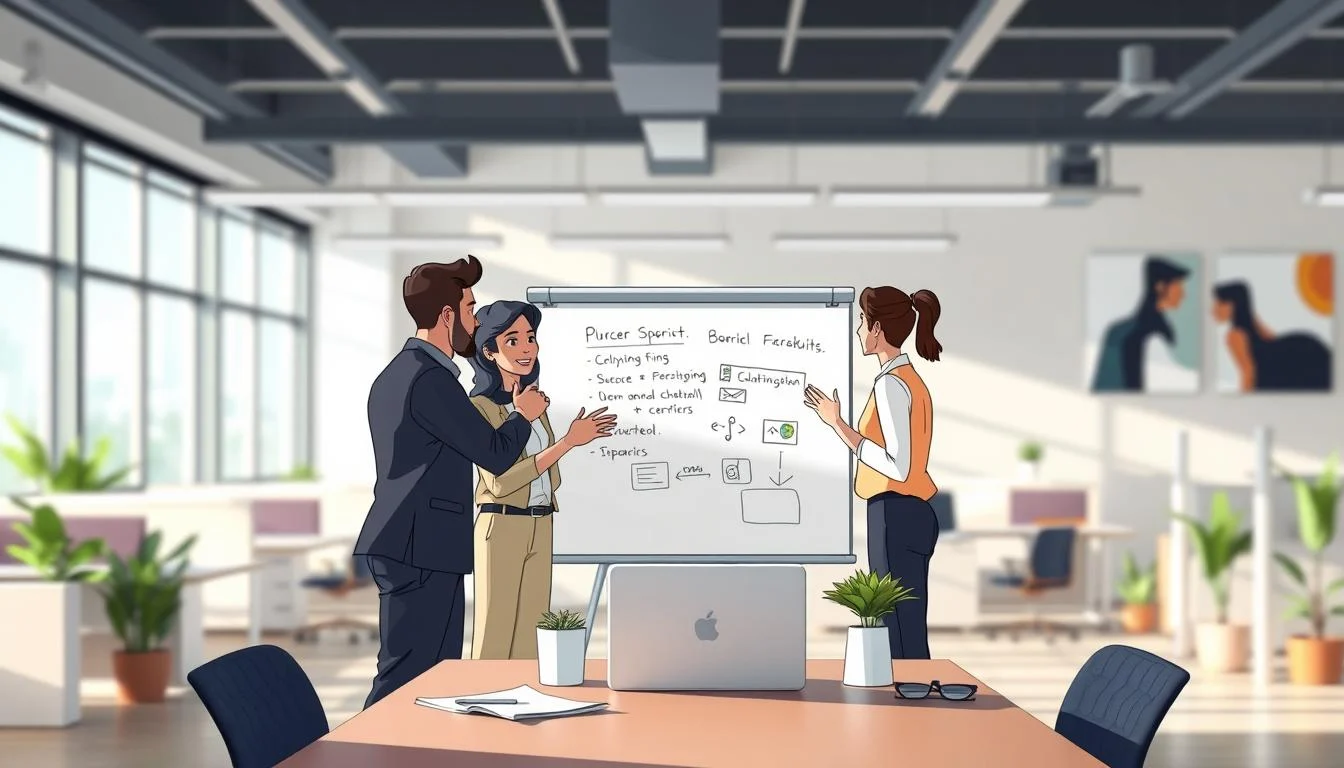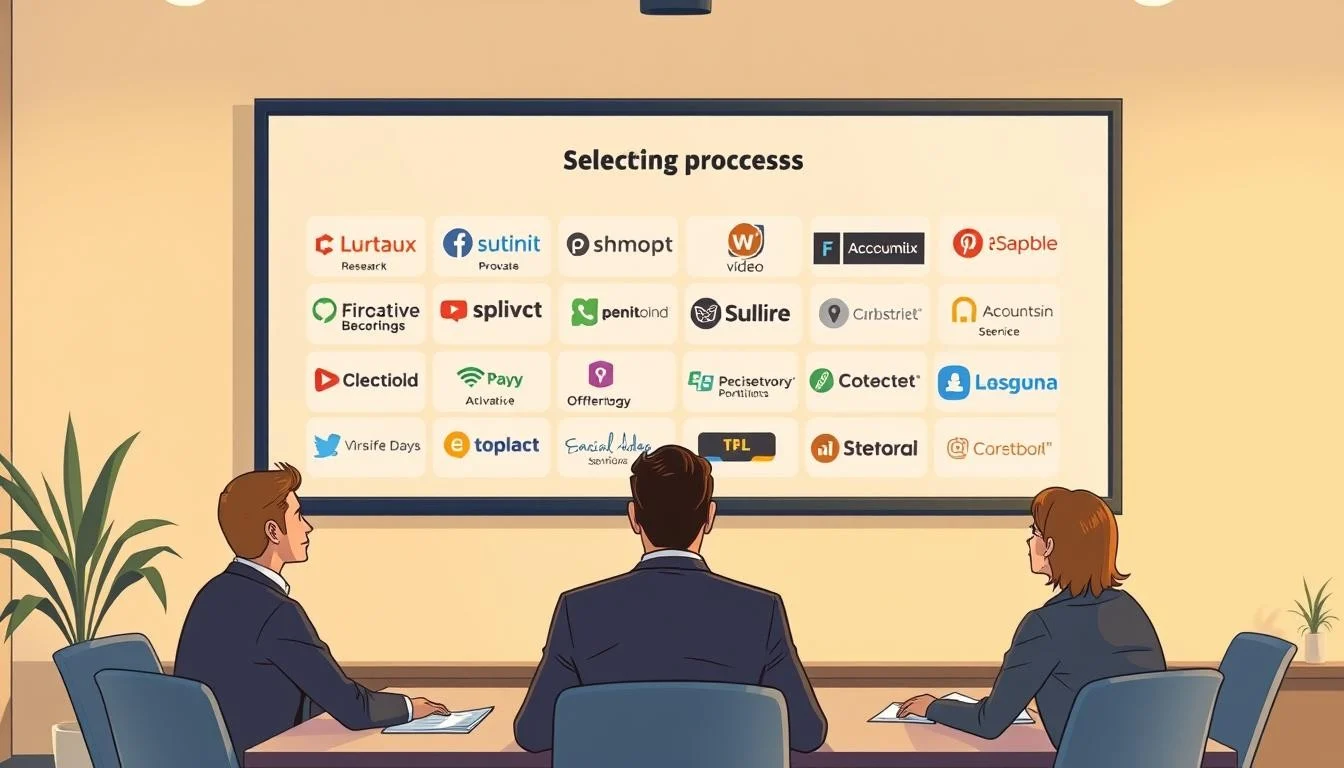Ever wondered why some ads hit it off with audiences while others don’t, even with big budgets? It often comes down to how well a brand tells its story. In today’s digital world, explainer videos are key for businesses to share complex ideas in simple, memorable ways.

I’ve helped companies make their messages stick through video content that connects with viewers. Seeing real people use real products creates a genuine bond that’s tough to beat with other formats.
In this guide, I’ll show you how to make live-action videos that boost brand awareness and drive sales. We’ll look at top examples that have shown real results and compare different ways to make them.
Whether you’re starting a new business or updating your brand’s marketing, these visual storytelling tips can make a big difference. Need help bringing your ideas to life? Find experienced freelancers who are experts in creating these engaging marketing tools.
Table of Contents
Key Takeaways
- Explainer videos significantly increase conversion rates and audience engagement
- Live-action formats create authentic connections through real human presence
- Effective videos simplify complex concepts in 60-90 seconds
- Professional production quality directly impacts viewer perception of your brand
- Strategic distribution across platforms maximizes your marketing investment
- Custom videos outperform generic templates in driving business results
What Are Live Action Explainer Videos?
Live action explainer videos are powerful tools for marketing. They use real footage to make complex ideas simple and connect emotionally. These videos show real people using products or services in real settings. This makes them great for building trust and connection with viewers.
Seeing real people use a product helps viewers imagine themselves doing the same. This makes complex ideas easier to understand. Live action videos are key for any marketing plan.
Definition and Key Components
Live action explainer videos use real people, locations, and products to share a message. They show real human expressions and interactions. This is different from animated content.
What makes these videos work includes:
- High-quality cinematography that grabs attention
- A compelling script that clearly conveys the message
- Professional actors or team members who connect with viewers
- Strategic storytelling that solves a problem
- Real-world settings that add context and relatability
How They Differ from Other Marketing Videos
Testimonials focus on customer experiences, and demos show product features. Live action explainer videos tell a complete story. They address customer pain points and show your solution in action. They create an emotional connection through human presence.
The main differences are:
- Greater emotional impact from human expressions and body language
- More credibility when showing real products in use
- A stronger sense of authenticity that builds trust
- The ability to show scale, texture, and physical interactions that animation can’t
These videos are best for showing how your product works in real life. They’re perfect for services like consulting, healthcare, or hospitality. In these fields, human interaction is key, making live action videos more impactful than animation.
🎥 Discover the Secret to Captivating Your Audience with Live Action Explainer Videos!
The Power of Live Action Explainer Videos for Business Growth
Live action explainer videos can change your marketing and help your business grow fast. They use real people to connect with your audience and show your products in real-life situations. Companies that use these videos often see more people engaging, buying more, and sticking with their brand.
Creating Authentic Human Connections
Live action videos are great at making human connections that touch your audience’s heart. When people see real faces solving real problems, they feel like they’re part of it.
The authenticity and relatability of real faces and actions build trust quickly. This is key when people buy based on feelings.

The best live action videos use feelings like joy and relief to share messages. These feelings stay with viewers, leading to more sales and loyal customers.
Showcasing Products in Real-World Settings
Live action videos are great for showing how products work in real life. Seeing a product solve a problem in a real setting makes it easier for viewers to imagine using it themselves.
These videos can highlight specific features in a real-world setting. This shows how your product improves life, making viewers more confident in their purchase.
Live action videos are special because they make viewers feel something while showing your tangible product. For example, a video showing a kitchen tool in action can show both its function and the joy it brings. This mix of benefits is powerful for selling.
By using everyday settings and relatable characters, you create scenarios viewers can imagine themselves in. This makes it easier for them to decide to buy.
🚀 Transform Your Brand’s Message into a Visual Masterpiece – Hire Experts Today!
Live Action vs. Animated Explainer Videos: Making the Right Choice
Deciding between live action and animated explainer videos is key. Each has its own strengths and limitations. Your choice should match your goals, budget, and audience. Let’s look at the main differences to guide your decision.
Comparing Costs and Production Timelines
Costs often shape the initial choice. Live action videos need more money for equipment, locations, and talent. You’ll spend on actors, crew, and possibly extra shooting days.
Animated videos might cost less upfront but need special skills. 2D animation is cheaper, but 3D can be pricier. Live action shoots are quicker, but animation takes longer as each frame is detailed.
| Factor | Live Action | 2D Animation | 3D Animation |
|---|---|---|---|
| Average Cost Range | $5,000-$20,000+ | $3,000-$15,000 | $10,000-$30,000+ |
| Production Timeline | 2-4 weeks | 3-6 weeks | 6-12 weeks |
| Revision Difficulty | High (may require reshoots) | Medium | Medium-High |
Effectiveness for Different Industries
Some industries prefer live action, while others choose animation. Service-based businesses like consulting and healthcare benefit from live action. It builds trust and connection.
Tech companies and those explaining complex ideas often use animation. It makes abstract concepts easier to understand. Financial services also use animation to simplify complex topics.
Hybrid Approaches: Combining Live Action with Animation
Hybrid videos blend real people with animation. They offer a balance that grabs attention and explains complex ideas.
For example, a software company might show real users with animated features. Medical companies use this to explain care while showing what’s happening inside the body.
This method is great for explaining invisible processes. It combines human connection with animation’s clarity. The result is often more memorable than either alone.
🔥 Unveil the Power of Live Action Explainer Videos to Skyrocket Engagement!
8 Essential Elements of Successful Live Action Explainer Videos
Creating a live action explainer video that converts requires eight key elements. These elements make the difference between a good video and a great one. They ensure your video doesn’t just explain but also persuades and drives results.
Compelling Scriptwriting and Storytelling
Exceptional scriptwriting is the foundation of a great explainer video. Your script should capture attention in the first 5-8 seconds and keep it throughout. Focus on customer benefits, not technical details.
A good script identifies a problem, presents a solution, and explains why it’s the best. Use simple language and avoid jargon. Your goal is to simplify complex ideas, not show off your vocabulary.
Professional Actors and Direction
The actors in your video are critical to its success. Professional actors who deliver lines naturally will enhance your message.

Direction is also key. A skilled director ensures performances feel real and not forced. Choose actors who reflect your target audience or someone they trust.
High-Quality Production Value
Quality videos don’t need big budgets but do require attention to detail. Good lighting and clear audio are essential. They ensure your message is clear and engaging.
Stable camera work and thoughtful composition keep viewers focused. Even with limited budgets, focusing on these elements shows professionalism and builds trust. The production process should support your message, not overshadow it.
Clear and Persuasive Call to Action
A successful video ends with a clear call to action. Be specific about what you want viewers to do next. This could be visiting a website or making a purchase.
Include both verbal and visual CTAs to engage viewers through multiple senses. The best calls to action create a sense of urgency and address concerns. Your entire video should lead up to this moment, making it compelling to act now.
📈 Watch Your Conversions Soar with Professionally Crafted Live Action Explainers!
8 Outstanding Live Action Explainer Video Examples to Get Inspired
Successful live action explainer videos share key qualities. Let’s look at 8 examples that get it right. These videos excel in storytelling, production, and messaging to achieve business goals. By learning from them, you can improve your marketing.

B2B Live Action Explainer Examples
B2B explainer videos face unique challenges. They must simplify complex topics, address pain points, and appeal to multiple decision-makers. The best ones turn technical features into compelling benefits, all while maintaining a professional tone.
Technology and SaaS Examples
Slack’s videos stand out by relating to workplace communication challenges. They show real office scenarios where communication fails.
“Slack’s genius lies in showing the before-and-after transformation. They don’t just tell you about features—they show you how those features solve real problems that plague office workers daily.”
Express VPN uses clear visuals and simple language to explain online privacy. Their videos balance technical info with everyday scenarios, making digital security easy to understand. They make an invisible service tangible through clever visuals.
Professional Services Examples
Mint.com makes personal finance management seem simple and stress-free. Their videos feature relatable characters facing financial challenges, then show how their dashboard simplifies complex money matters. The production quality is high, with clean graphics that enhance the live action.
Med Mart’s plastic surgery video is detailed and transparent. It walks viewers through the surgical process. By showing real medical professionals in authentic settings, it builds trust and educates about what to expect.
B2C Live Action Explainer Examples
Consumer-focused videos must grab attention quickly and create emotional connections. The best ones use humor, relatability, and aspirational messaging to engage and convert viewers. These examples show how to turn viewers into customers through compelling stories.
Product Demonstration Examples
Dollar Shave Club’s video is a classic in this category. It has over 27 million views and revolutionized product marketing. The founder’s direct-to-camera delivery, humor, and clear value proposition make it unforgettable.
The video’s success comes from its authenticity. It doesn’t feel like marketing but like a friend telling you about something cool. The production quality is professional but has a deliberate roughness that fits the brand’s straightforward approach.
Stitch-fix focuses on the customer experience in their video. They show real people receiving and trying on personalized clothing. The genuine reactions create desire and address concerns about online styling services. The video features diverse models, making it relatable for various viewers.
Service-Based Business Examples
Moved.com tackles the stressful process of relocating with an explainer video. They show their service as the solution to moving anxiety. The video visualizes the contrast between traditional moving chaos and their streamlined approach, clearly showing the value.
Spotify’s videos focus on the emotional benefits of their service, not just technical features. They connect music to life moments, showing how the platform enhances everyday experiences. The production quality reflects the brand’s sleek aesthetic while staying authentic and human.
| Company | Video Length | Key Strength | Storytelling Approach | Call to Action |
|---|---|---|---|---|
| Dollar Shave Club | 1:33 | Humor | Founder-led narrative | Direct subscription offer |
| Slack | 2:15 | Problem-solution format | Office scenario recreation | Free trial signup |
| Moved.com | 1:45 | Emotional relief | Before/after comparison | Schedule consultation |
| Mint.com | 1:52 | Simplification | Character-based journey | App download |
| Express VPN | 1:28 | Visual metaphors | Educational approach | Security assessment |
These outstanding video examples show that success doesn’t need a big budget. They require clear messaging, authenticity, and strategic storytelling. By learning from these examples and applying their techniques, you can create videos that engage your audience and drive business results.
🎯 Target Your Audience Effectively with Customized Live Action Video Content!
How to Plan Your Live Action Explainer Video Project
Before you start filming your live action explainer video, a detailed planning phase is key. A well-planned video saves time and money. It also makes sure your message hits the mark with your audience.
Creating a video that works well needs careful planning in several areas. Let’s look at the main steps to make your explainer video a success.

Setting Clear Objectives and KPIs
Every video project starts with clear goals. Do you want to boost brand awareness, explain a product, or drive sales? Your goals will guide every choice you make.
I suggest settingSMART goals for your video. For example, aim to increase product page conversions by 15% in three months.
Choose clear KPIs that match your goals. These could be view count, watch time, or social shares. These metrics help you see if your video is working and bringing in returns.
Developing Your Script and Storyboard
The script is the heart of your explainer video. I break scriptwriting into six steps:
1. Define your core message (what problem do you solve?)
2. Identify your audience’s pain points
3. Introduce your solution clearly
4. Keep language conversational and accessible
5. Aim for 60-90 seconds (about 150-225 words)
6. End with a compelling call to action
After your script is ready, make a storyboard. It doesn’t need to be artistic. Simple sketches with notes on camera angles and key visuals are enough.
Your storyboard is a tool for your production team. It makes sure everyone knows how your video will look and feel.
Budgeting for Maximum Impact
Good budgeting for explainer videos means balancing quality and cost. Allocate your budget across three main phases:Pre-production(20-30%): Covers scriptwriting, storyboarding, and planning.Production(40-50%): Includes filming, equipment, and crew costs.Post-production(30-40%): Covers editing, sound design, and music.
Invest in audio quality and talent for the biggest impact. Viewers can forgive some visual flaws but poor audio or acting will hurt your message.
| Budget Level | Typical Cost Range | What to Prioritize | What to Consider Scaling Back |
|---|---|---|---|
| Low Budget | $1,000-$5,000 | Script quality, audio clarity, simple location | Multiple filming locations, complex effects |
| Mid-Range | $5,000-$15,000 | Professional talent, better equipment, basic graphics | Large crew, elaborate sets |
| High-End | $15,000-$50,000+ | Premium talent, multiple locations, custom graphics | Consider if each element truly adds value |
By planning your objectives, script, and budget well, you lay a strong foundation for your video. This prep work ensures your production goes smoothly and your video meets your goals.
💡 Illuminate Your Product’s Value with Engaging Live Action Explainer Videos!
The Complete Production Process for Live Action Explainer Videos
Every successful live action explainer video starts with a detailed production process. This process needs careful planning and execution. I’ve helped many clients through this journey. Understanding each phase helps set realistic expectations and ensures a smooth experience.
The production process has three main stages. Each stage has its own challenges and goals.
Pre-Production Planning and Preparation
Pre-production lays the foundation for your video project. It usually takes 2-3 weeks. During this time, we finalize your script, create storyboards, and find locations that match your brand.
We also cast the right talent to represent your brand. The production team, including directors and camera operators, will bring your video to life.
Creating a detailed shot list and schedule helps avoid mistakes. We also plan for unexpected challenges like weather delays. Good planning prevents budget overruns and missed deadlines.

Shooting Day Essentials and Best Practices
The shooting day turns your plan into raw footage. It usually lasts 8-10 hours. We need to coordinate talent, crew, and clients carefully.
Arriving early to set up equipment saves time. We capture multiple takes and angles for editing flexibility. Professional sound recording is key—viewers forgive bad visuals but not bad audio.
Keeping energy high on set is important. Short breaks and clear communication ensure we get what we need. A well-organized shoot leads to high-quality footage.
Post-Production, Editing, and Delivery
Post-production turns raw footage into a polished product. It usually takes 2-4 weeks. We start by organizing footage and selecting the best takes.
The initial rough cut sets the structure. We then refine the pacing and flow. Adding voiceover, music, and sound effects creates the emotional foundation. Color grading and motion graphics enhance the video.
Before finalizing, we offer at least two client revisions. The final package includes formats for different platforms. This ensures your video looks great wherever it’s shown.
🌟 Stand Out in Your Industry with Unique Live Action Video Presentations!
Top Live Action Explainer Video Services
Live action explainer video services have grown a lot. They now fit every budget and business need. Whether you’re big or small, there’s a service to bring your idea to life. Let’s look at what’s available and find the best match for your project.
Full-Service Production Companies
Full-service video production companies handle everything from start to finish. They have teams of experts like directors and editors. This ensures your video is made well and looks great.
Enterprise-Level Services
Big companies with big budgets can get top-notch results from enterprise studios. These studios cost $10,000-$50,000+ but offer great quality. Brands like Sandwich Video and Epipheo have made many successful videos.
These services do more than just make videos. They create strategies that fit your marketing plans. They use high-quality equipment and actors to connect with viewers.
Mid-Market Solutions
For businesses growing, mid-range options are great. Companies like Explainify offer quality videos for $5,000-$15,000. They make videos without the high cost of big studios.

Mid-market providers focus on specific areas. This helps them work efficiently and keep quality high. They often have package deals that include script and editing.
Freelance Professionals for Different Budgets
Freelancers are a good choice for smaller budgets. They offer personalized service and direct access to the creators. This can make your video feel more special.
| Service Type | Typical Budget Range | Best For | Turnaround Time | Key Benefit |
|---|---|---|---|---|
| Enterprise Studios | $10,000-$50,000+ | Large corporations | 4-8 weeks | Premium production value |
| Mid-Market Studios | $5,000-$15,000 | Growing businesses | 3-6 weeks | Quality-price balance |
| Freelance Team | $3,000-$10,000 | SMBs with specific vision | 2-5 weeks | Direct creative control |
| Solo Freelancers | $1,000-$5,000 | Startups, local businesses | 1-4 weeks | Cost-effectiveness |
Finding and Hiring Qualified Freelancers
Finding the right freelancer is key. Use platforms like Fiverr to see portfolios from around the world. Look at their work, client feedback, and how they communicate.
Ready to hire a freelancer for your explainer video? Check out this platform for vetted professionals for every budget.
Managing Freelance Video Projects Successfully
Working with freelancers means you need to manage more closely. Start with a clear brief and contract. This should cover what you need, when, and how much you’ll pay.
Break your project into steps and check in often. Use tools like Frame.io to track progress and give feedback. This helps keep your project on track.
Make sure your contract protects your rights. Also, plan for revisions to avoid extra costs and delays.
How to Choose the Right Live Action Explainer Video Service
Finding the right live action explainer video service is not easy. There are many companies out there, each promising to create amazing content. But how do you know who will truly deliver? It’s not just about the price or what they’ve done before.

Essential Questions to Ask Before Hiring
Before you choose a video production partner, ask these important questions. They will help you see if they’re a good fit for your project:What is your experience in my specific industry?Look for someone who knows your market well and has made successful videos for similar businesses.Can you walk me through your creative and production process?A clear explanation shows their professionalism and organization.Who will handle the key aspects of my project?Knowing who will direct, shoot, and edit your video is important for accountability.What rights and ownership will I have over the final product?Make sure you’ll have full rights for all distribution channels you might need.
The relationship between client and video producer is like a temporary marriage. Choose someone you trust to bring your vision to life while respecting your business objectives.
What is your revision policy?Understanding how many changes are included can prevent future problems.How do you measure video success?Their answer shows if they focus on the right metrics for your business.
Red Flags to Watch For in Service Providers
Be careful of warning signs when choosing a live action explainer video partner: Vague or constantly shifting pricing structures often hide extra costs. Portfolios lacking variety or depth may show limited experience or a one-size-fits-all approach. Poor communication during initial interactions usually gets worse, not better, once production starts. Reluctance to provide client references may mean past customers were unhappy or they lack experience.
| Quality Indicator | Good Sign | Red Flag |
|---|---|---|
| Response Time | Prompt, thorough replies | Delayed, vague answers |
| Portfolio | Diverse, industry-relevant work | Generic templates, outdated styles |
| Testimonials | Specific, verifiable feedback | Anonymous or overly generic praise |
| Process Explanation | Clear milestones and deliverables | Ambiguous workflow description |
Be cautious of providers making unrealistic promises about results or timelines. Quality videos take time to make. Also, watch out for companies that can’t explain how they’ll show your unique benefits or have copyright issues in their past work.
Finding the right partner means looking for someone who understands your business goals and can tell your story visually. It’s more important than just their technical skills or price.
🎬 Bring Your Story to Life – Explore Live Action Explainer Video Services!
Measuring the Success of Your Live Action Explainer Video
Success in live action explainer videos isn’t just about quality and creativity. It’s also about measuring how well your video content does its job. By tracking performance, you can see if your video is meeting its goals and giving you a good return on investment. Let’s look at the important metrics and tools for analyzing them.
Key Performance Indicators to Track
For brand awareness campaigns, focus on view counts, reach, and impressions. These numbers show how many people have seen your message.
Engagement metrics like watch time and completion rates show if your video is interesting. Social shares and comments tell you if your engaging video connects with people. Good engagement means your video has made an emotional impact.
For videos aimed at getting people to take action, track click-through rates, form completions, and direct sales. These metrics show how your video is helping your business. Industry standards vary, but high completion rates and CTRs are usually a good sign.
Tools and Platforms for Analyzing Video Performance
Each hosting platform has its own strengths in analytics. YouTube Analytics is great for understanding your audience. Wistia, on the other hand, offers detailed viewer engagement data to see what parts of your video resonate deeply with viewers.
| Platform | Strength | Best For | Key Metrics |
|---|---|---|---|
| YouTube Analytics | Audience Demographics | Wide Distribution | Watch Time, Audience Retention |
| Vimeo Analytics | Clean Interface | Professional Showcase | Engagement, Geography |
| Wistia | Engagement Graphs | Lead Generation | Heatmaps, Conversion |
| Google Analytics | Website Integration | Conversion Tracking | Events, Goal Completion |
Tools like VidIQ and TubeBuddy offer insights into competition and SEO. For a full picture, set up your tracking system before you launch your video. This way, you can start collecting data right away and keep improving your video strategy based on real results.
📢 Amplify Your Marketing Strategy with High-Quality Live Action Videos!
Common Mistakes to Avoid When Creating Live Action Explainer Videos
Creating a live action explainer video can be tricky. Small mistakes can hurt your marketing efforts. Knowing these common errors can save you time and money. It ensures your video does what it’s meant to do.
Script and Messaging Pitfalls
Scriptwriting is key to a good explainer video. But, many projects fail here. The biggest mistake is trying to fit too much into a short video. This confuses viewers and weakens your main message.
Another mistake is talking about features instead of benefits. People want to know how your product solves their problems. For example, say “you’ll sleep better knowing your systems are protected” instead of “our software has 24/7 monitoring.”
“The best explainer videos don’t explain everything – they explain the right things in the right way.”
Unclear value propositions are another problem. If viewers don’t get it by the end, your script has failed. Weak calls to action also waste the engagement you’ve built.
To avoid these mistakes, create a script template. This helps you focus on your main message. Have someone new to your product review the script. If they don’t see the value, revise until they do.
Production Quality and Technical Issues
Even a great script can be ruined by poor video production quality. Audio issues like background noise or unclear dialogue can lose viewers. Invest in good microphones and controlled recording spaces.
Bad lighting makes your video look unprofessional. You don’t need expensive gear. Even simple lighting setups can make a big difference.
- Shaky camera work that distracts from your message
- Awkward acting that makes viewers uncomfortable
- Inconsistent branding elements across scenes
- Poor editing with jarring transitions or pacing issues
When working with actors, guide them but let them be real. Overly scripted acting can seem fake. Remember, engaging video content connects on a human level first.
If you find technical issues after filming, editing can help. But prevention is better. Create a technical checklist and test all equipment before filming.
While you don’t need perfection, quality is key for credibility. Viewers will forgive small flaws if your message is clear and real. Focus on making high-quality content that’s easy-to-understand, not perfect production at any cost.
Conclusion: Elevating Your Marketing with Live Action Explainer Videos
This guide has shown how live-action video turns regular marketing into powerful stories. The real people in these videos make them relatable. When viewers see real people using your product, they imagine themselves doing it too.
Effective explainer videos have a clear goal and are made professionally. You can use live-action or mix it with animation for complex ideas. Some brands use 3D to show off features while keeping it real.
The world of video is always changing, with viewers wanting better quality every year. Investing in quality videos boosts engagement, keeps viewers longer, and increases sales. A good explainer video works for you 24/7 as a digital salesperson.
Are you ready to make your own live-action explainer? Find skilled freelance video pros who can make your idea come to life, no matter your budget. With the right team and this guide, you’re set to make videos that really connect with your audience.
FAQ
For “Live Action Explainer Video Examples & Services”
Q: What are live-action explainer videos and how do they differ from animated videos?
A: Live-action explainer videos are a type of video that feature real people, physical settings, and tangible products to explain a concept, product or service. Unlike animated videos which use animated characters and graphics, live-action explainers provide a human touch that can help viewers relate to your message more easily. They offer an authentic way to convey messages and often resonate with your audience on a more emotional level. Many successful live-action explainer videos also incorporate animated elements or 3D elements to highlight key points while maintaining the connection that comes from seeing real people on screen.
Q: What are the benefits of using a live-action explainer video for my product or service?
A: Live-action explainer videos offer several advantages for showcasing your product or service. They provide authenticity through real human interactions, allowing your audience to better connect with your brand. These videos can demonstrate your product in actual use scenarios, which helps viewers visualize themselves using it. The human touch in live action video creates emotional engagement that’s difficult to achieve with animation alone. Additionally, live-action explainers can establish trust and credibility, especially for premium products or services where seeing is believing. They’re particularly effective when customer testimonials or expert opinions would strengthen your message.
Q: How do I decide between animation vs live-action for my explainer video?
A: When choosing between animation vs live-action for your explainer video, consider your objectives, audience, and content. Live-action is ideal when you want to showcase physical products, real people using your service, or when you need to establish trust through human connection. It works well for tangible products and services where seeing is believing. Animation might be better for abstract concepts, future products that don’t exist yet, or when you need to visualize data or internal processes. Your budget and timeline are also factors—sometimes a mix of live-action and animation provides the best of both worlds, combining the relatability of real people with the flexibility of animated graphics to explain complex ideas.
Q: Where can I find examples of the best live action explainer videos to get inspired?
A: You can find examples of the best live action explainer videos across various platforms. YouTube channels of major brands often feature high-quality videos that effectively explain their products or services. Websites like Vimeo showcase curated collections of explainer videos to get inspired. Video production company portfolios typically highlight 8 live action explainer videos or more from different industries. Sites like Wistia, Vidyard, and Vidico feature case studies of successful live-action explainers. Industry award platforms like the Webby Awards or Telly Awards can also point you to exemplary videos that resonate with audiences and effectively communicate their message.
Q: How much does a professional live-action explainer video typically cost?
A: The cost of a professional live-action explainer video varies widely based on several factors. Entry-level productions might start around $3,000-$5,000, while mid-range videos typically cost between $5,000-$15,000. High-end live-action explainer videos with top talent, multiple filming locations, and premium production quality can range from $15,000 to $50,000 or more. Factors that influence cost include script complexity, filming locations, talent (actors and crew), equipment requirements, and post-production needs like special effects or use of 3D elements. Remember that while live-action videos sometimes have higher upfront costs than animated videos, they often deliver strong ROI through better audience engagement and conversion rates.
Q: What elements make a live-action explainer video effective?
A: An effective live-action explainer video combines several key elements. First, it needs a concise, compelling script that addresses your audience’s pain points and clearly communicates your solution. Second, authentic performances from relatable actors help your viewer to relate to the situation being presented. Third, professional production quality with good lighting, clear audio, and steady camerawork ensures your message isn’t lost due to technical issues. Fourth, strategic pacing keeps viewers engaged throughout. Finally, a strong call-to-action directs viewers on next steps. The most successful videos also maintain brand consistency, incorporate subtle animated elements when helpful for explanation, and tell a story that resonates with your audience rather than just listing features.
Q: How long should a live-action explainer video be?
A: The ideal length for a live-action explainer video typically ranges from 60-90 seconds. This duration is long enough to effectively explain your product or service while maintaining viewer attention. For complex offerings, you might extend to 2 minutes, but remember that viewer engagement tends to drop significantly after that point. Social media platforms often require shorter formats (30-60 seconds), while detailed product demonstrations might justify 2-3 minutes. The key is to be concise—focus on one core message rather than trying to explain everything about your offering. Remember that different platforms and contexts may require different video lengths, so consider creating versions of varying lengths for different channels.
Q: Can I combine live-action and animation in my explainer video?
A: Yes, combining live-action and animation in explainer videos is not only possible but often creates particularly effective content. This hybrid approach leverages the authenticity and human connection of live-action footage while using animated elements to visualize abstract concepts, highlight key features, or show what can’t be easily filmed. For example, you might show real people using your product while animated graphics appear to illustrate how it works internally. This combination can make complex information more digestible and engaging. Many of the most successful explainer videos use this blended approach, creating videos that resonate with audiences on multiple levels while clearly explaining features and benefits.
Related Articles:
- Animated Explainer Video Production & Animation
- Screencast Video: Screen Recording and Comprehensive Video Editor Guide
- E-Learning Video Production: Your Guide to Engaging Videos
- Crowdfunding Video Production: Top Effective Kickstarter Video Services
- Article to Video: Turn Articles into Engaging AI Video
This post contains affiliate links, which means I may earn a commission if you make a purchase through these links. There is no additional charge to you! Thank you for supporting my blog so I can continue creating free content each week!





